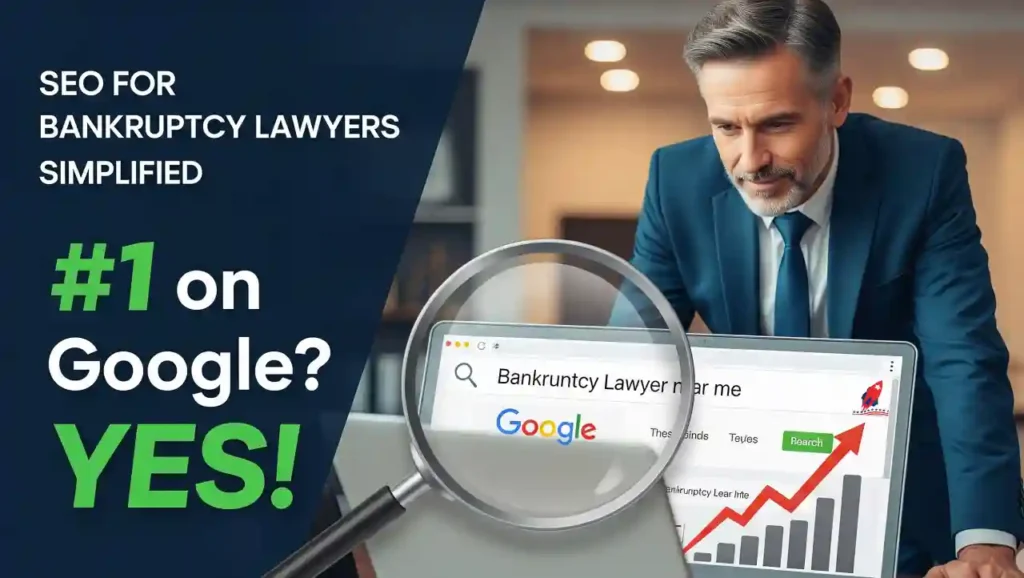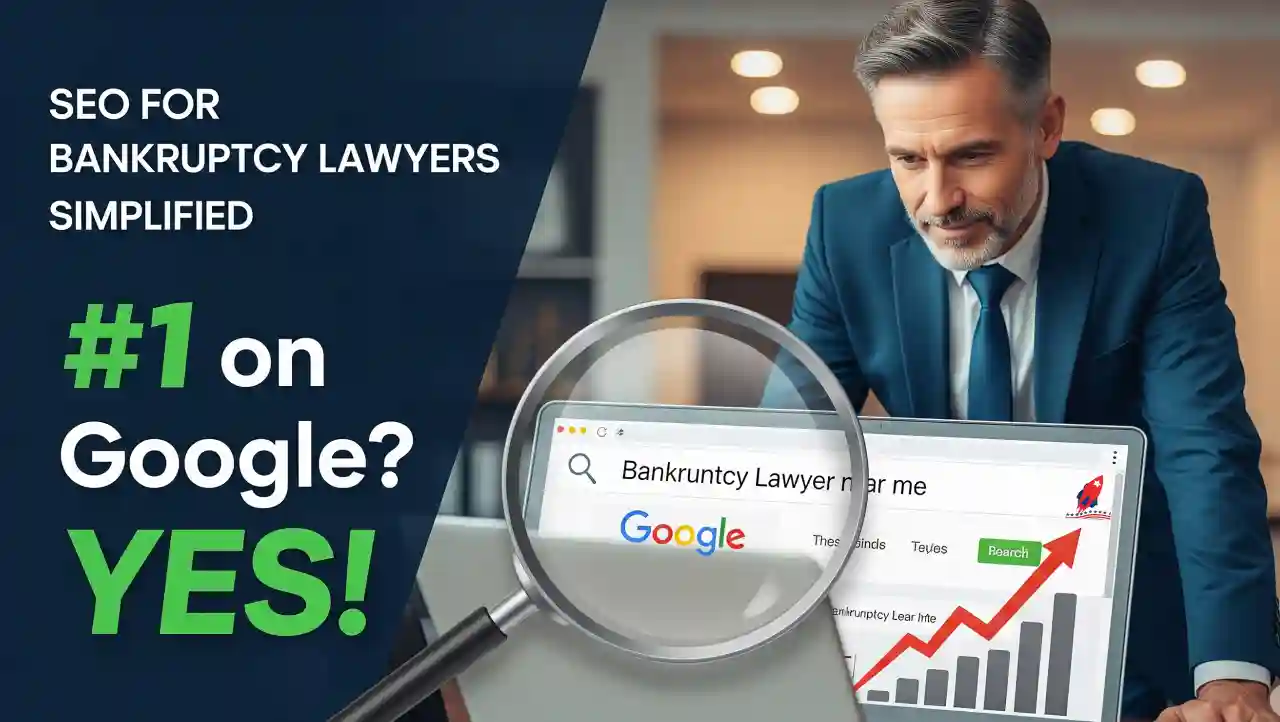In today’s digital age, people no longer turn to newspapers or the Yellow Pages to find an attorney. They search directly on Google – searches like “bankruptcy lawyer near me”, “Chapter 7 attorney in Ohio”, or “how much does a bankruptcy lawyer cost” are now common. So if your law firm is not ranking on top on Google, you are already losing potential clients to your competitors.
SEO for Bankruptcy Lawyers is no longer just a technical term, but a necessity. Whether you are an independent lawyer or associated with an established bankruptcy law firm – if you want clients to find and contact you online, it is vital to practice Search Engine Optimization (SEO).
Millions of people in the US today are facing financial crisis and are looking for bankruptcy attorneys. So if your website isn’t on the first page of Google, you’re missing out on a lot of clients.
This guide is specifically designed for bankruptcy lawyers and law firms in the U.S. who:
- Want to move up the Google rankings
- Want to reach people who are already looking for legal help
- Want to strengthen their law firm’s online presence and trust

In this article, we’ll break down SEO in simple terms — keyword research, on-page SEO, local SEO, and link building — so you can turn your website into a powerful client-bringing machine.
**Let’s simplify SEO, and get your law firm to the top of the digital world.**
🔹Core SEO for Bankruptcy Lawyers: Key SEO Strategies for Bankruptcy Lawyers
The foundation of success in SEO i.e. Search Engine Optimization rests on four strong pillars — keyword research, on-page SEO, local SEO, and content marketing. All of these together help your website rank higher in Google and reach more clients.
✅ Keyword Research & Targeting
SEO starts with choosing the right keywords. You need to understand what people are typing on the Internet when they need bankruptcy-related legal help.
🔍 Useful keywords:
- bankruptcy lawyer near me
- chapter 7 attorney in Ohio
- how to file for bankruptcy in [state name]
- how much does a bankruptcy lawyer cost in USA
👉 Long and clear keywords (Long-Tail Keywords) bring more conversions because they reflect the needs of users more clearly. For example: “how to declare bankruptcy without a lawyer in Texas” indicates a more serious user who wants immediate help.
✅ On-Page SEO
Every page of your website is an opportunity to impress both Google and the user. On-page SEO includes the following points:
- Title Tags: Every page title should be SEO-friendly — e.g.:
- “Affordable Chapter 13 Bankruptcy Lawyer in Los Angeles”
- Meta Description: A short, catchy, and keyword-inclusive description that will show up on SERPs.
- Header Tags (H1, H2, H3): Keep content organized and include main keywords.
- URL Structure: Be clear, concise, and keyword-rich.
- E.g.:
- ✔️ https://adzomo.com/seo-for-bankruptcy-lawyers/
- ❌ yourlawfirm.com/page-id=4528?type=legal1
- E.g.:
- Content Optimization: Use 1-2 focus keywords, and 2-3 supporting keywords on each page.
✅ Local SEO
Most people in the USA search for lawyers by typing “near me” or the name of their city — e.g.: “bankruptcy lawyer in Dallas” or “best chapter 7 attorney near Chicago”
Important Local SEO Tasks:
- Optimize Google Business Profile (GBP): Name, Address, Phone Number (NAP) should be accurate and consistent.
- List in Local Directories: Avvo, Justia, Yelp, Nolo, etc.
- Client Reviews: Try to get 5-star reviews on Google from your clients — it increases both ranking and trust.
- Local Schema Markup: Tell Google you are a local legal business.
✅ Content Marketing
Your content is the bridge that leads users to you. So:
What to create?
Blog posts: like
- “How to File for Chapter 13 Bankruptcy in California”
- “Should I Declare Bankruptcy Without a Lawyer?”
- FAQ page: Answer common questions
- Guides and checklists: like “Step-by-Step Bankruptcy Filing Process in New York”
How to write?
- Simple and clear language
- Target the client’s pain points
- Avoid legal jargon — your language should be understandable to the client, not just Google
Technical & User Experience SEO for Your Website
A great website should not only look beautiful, but also be fast, secure, and user-friendly. Google prefers pages that are not only keyword-rich but also technically sound. The following technical and UX aspects help strengthen SEO:
✅ Website Speed:
🧭 Why is it important?
Website speed in the US directly affects user satisfaction and bounce rate. Google also prioritizes faster websites in rankings.
⚙️ How to improve?
- Compress images (use tools like TinyPNG)
- Minify CSS/JS files
- Choose better hosting (U.S.-based server is even better)
📌 Example: If your website is taking more than 3 seconds to load, 40% of visitors leave without visiting.
✅ Mobile Optimization:
📱 Why is it important in today’s era?
More than 70% of users in the US search for lawyers on Google from mobile. Google follows “Mobile-First Indexing” — meaning your mobile site is considered the real site.
👇 Make these improvements:
- The website should be fully responsive
- CTA buttons (such as “Free Consultation“) should be large and clear
- Form fields should be mobile-friendly
✅ Website Crawlability & Indexability:
🔍 Why is it important?
If Google bots are unable to crawl your website, then that page will not rank.
🔧 How to improve?
- Configure robots.txt file properly
- Create XML sitemap and submit it to Google Search Console
- The canonical tag of every page should be correct so that there is no problem of duplicate content
✅ Security and Trust (Website Security & HTTPS):
🔐 Why is it important?
In the USA, clients share sensitive information with legal websites. Google now prefers HTTPS websites considering them safe.
🛠️ What to do?
- Install SSL certificate (URL should start with https://)
- If your form is taking client data, then SSL is mandatory
✅ Core Web Vitals (User Experience Metrics):
According to Google, these are the three main factors to measure the UX of a website:
| Metric Name | Meaning | Good score |
|---|---|---|
| LCP (Largest Contentful Paint) | How quickly the main content of the page loads | < 2.5 seconds |
| FID (First Input Delay) | How responsive is the first interaction | < 100ms |
| CLS (Cumulative Layout Shift) | How stable is the page layout | < 0.1 |
✔️ Good performance on all of these moves your website ahead in the rankings.
🔹Off-Page SEO Strategies: Essential Steps to Increase Website Credibility and Ranking
As important as on-page SEO is, off-page SEO is equally important — that is, all the activities done outside your website that show Google that your website is trustworthy, reputable and useful. Especially in the USA, where there are hundreds of bankruptcy lawyers active in every city and state, it is not enough to just decorate your website to prove yourself different. You also have to bring signals from the outside world for your website, and that is what Off-Page SEO techniques do.
When other reputable websites — such as Justia, Avvo, FindLaw or local news portals — share links to your site, Google understands that you have valuable content that others trust. This trust directly affects ranking. That is why off-page SEO is also called the “trust-building pillar” of SEO.
✅ Backlink Building: Increase your website’s reputation in the eyes of Google
Backlinks are when another website links to one of your pages. These links act as an endorsement for you — like someone credible saying something good about you. Google pays special attention to this. But remember, it’s not just the number of backlinks, but their quality and relevance that matters the most.
Some effective ways to get backlinks for bankruptcy lawyers working in the USA are:
- Guest posting: You can write articles on finance or legal blogs, such as “How to File Chapter 7 Bankruptcy in California” and include a link to your site.
- Local business directories: Create your profile on Avvo, Justia, Nolo, SuperLawyers. These directories are the most reliable sources of legal backlinks.
- Press Releases and Local News Websites: If you have won a special case or organized a community legal event, prepare a press release on it and get it published in the local media.
- Broken Link Building: Many websites in the legal niche have old or dead links. Find such links and suggest your updated content in their place.
A strong backlink profile not only brings your website up in SEO, but also strengthens the credibility of your law firm in the minds of users.
✅ Social Media Engagement: An effective way to increase user trust and brand awareness
Social media is not limited to just likes and shares. In today’s digital world, it has become an effective medium to support your SEO. Especially in the USA, people are active on platforms like LinkedIn, Facebook, Instagram, and YouTube and get information about lawyers from there.
If you regularly share legal content, FAQs, quick tips or blog posts on social media, it drives social traffic to your website, which tells Google that your content is valuable and people are engaging with it.
You can use social media in these ways:
- Post informative legal articles on LinkedIn, such as “5 Mistakes to Avoid Before Declaring Bankruptcy in Ohio”
- Share FAQs and client success stories on Facebook
- Create Instagram Reels or YouTube Shorts in which you provide basic legal tips in 30–60 seconds — such as “Can you file for bankruptcy without a lawyer?”
- Make sure to share each new blog post on social media and add a call-to-action (CTA)
Google doesn’t directly consider social shares as a ranking factor, but the traffic and brand awareness they generate do strengthen SEO.
✅ Online Review Management: Build client trust and local SEO
Reviews are not only important for reputation management but also for local SEO. In the USA, legal clients read reviews on Google, Yelp, and Avvo before contacting any lawyer. Even more and positive reviews on Google Business Profile help boost your local ranking.
You should keep these things in mind:
- Request every satisfied client to leave a review on Google
- Make the process easy for them — like sending a direct link via WhatsApp or Email
- Reply politely to all reviews — even if the review is negative
- Get reviews from clients with city/state names — like “Mr. Roy helped me file Chapter 13 bankruptcy quickly in Phoenix”
These types of reviews not only show Google your relevance to your city, but also help you win the trust of new users quickly.
🔹Measuring Performance and Improvement: How to track SEO success?
SEO is not a one-time process — it is an ongoing strategy that requires periodic performance monitoring and necessary improvements. As a bankruptcy lawyer, when you are working hard on your website and online presence, you need to know how much of that effort is working.
Is your website getting traffic? Are people calling or filling out forms? What keywords are people searching for you? All these questions will be answered only when you measure your SEO performance properly.
There is a lot of competition in the USA, especially in legal niches. So if you do not monitor your website constantly, your competitors may leave you behind in the rankings. SEO is something that Google keeps changing constantly, and user behavior also changes over time. In such a situation, it becomes important that your website evolves according to time, and this is possible only when you look at your data carefully and make decisions based on that.
✅ Use the Right SEO Tools:
There are some important free and paid tools available to track SEO performance, which every bankruptcy lawyer should use:
- Google Analytics: This will tell you how many people are visiting your website, which pages they are viewing, how long they are staying, and from which devices they are coming. This is the most important tool to understand user behavior.
- Google Search Console: This tool tells you which keywords your site is ranking for, how many times your links are clicked (CTR), and whether there are any errors that are preventing Google from indexing.
- Call Tracking Tools (like CallRail): In the USA, calls have a higher conversion rate than filling forms on legal websites. Call tracking lets you know which page or keyword drove the call, making it easier to track ROI.
- Rank Tracking Software (like Ahrefs, SEMrush, Ubersuggest): This lets you know which keywords your website is ranking in which position and whether it is declining or improving.
✅ Which Performance Metrics to Track (Key SEO Metrics to Monitor):
When you measure SEO performance, just looking at traffic is not enough. The key metrics below give you a holistic view:
- Organic Traffic: Unpaid traffic from search engines like Google. This is the most direct result of SEO.
- Keyword Rankings: What positions are your target keywords (like “chapter 7 lawyer near me”) ranking in?
- Bounce Rate: How many people visit your website and then leave immediately. A high bounce rate indicates a lack of UX or content.
- Conversion Rate: How many visitors are calling, filling out a form, or booking a consultation — that’s the real win.
- Page Load Speed & Mobile Usability: These metrics affect user experience and play a big role in Google’s rankings.
✅ Conduct Regular SEO Audits:
Make sure to conduct a full SEO audit of your website once every 2–3 months. This lets you know which pages are outdated, where there are broken links, or which content is not performing. During a comprehensive audit, you can check the following aspects:
- Are all title tags and meta descriptions optimized?
- Are there any duplicate content?
- How the website looks in mobile view?
- Core Web Vitals score
- Is the internal linking structure strong?
💡 If you want, you can also consult a professional agency for technical SEO audits.
SEO is an ongoing process that involves measurement, analysis, and improvement in a cycle. If you only implement SEO strategies but don’t track performance, you’re ignoring your most valuable data.
A successful bankruptcy law firm is one that constantly refines its digital marketing efforts based on data and analysis. So, check the health of your SEO from time to time and make adjustments to your strategies as needed.
🔹Conclusion: Why SEO is a Future Essential for Every Bankruptcy Lawyer
In today’s digital age, where every potential client takes their first step with a Google search, SEO (Search Engine Optimization) has become not just a technical tool but an essential business strategy — especially for bankruptcy lawyers working in a competitive market like the USA.
If your law firm is not showing up on Google, it simply means that your potential clients are going to your competitors. Through this guide, you learned how proper keyword research, effective on-page SEO, strong local SEO, reliable backlinks, and a user-friendly website structure can combine to make your website a client-generating machine.
We also understood that just building a website is not enough — it is also important to keep it fast, mobile-friendly, secure, and regularly updated. Also, being active on social media, getting Google reviews, and keeping an eye on performance metrics can also lead to long-term success.
Your SEO strategy is not a one-time job, but an ongoing process. The full results of the strategy you implement today will be visible in the months to come — but only if you continue to monitor, refine, and innovate.
If you don’t want to rely on referrals or word-of-mouth to run your business and have clients in need reach you directly from Google, now is the time to take SEO seriously.In today’s competition, only those lawyers and law firms are getting ahead who are looking at digital marketing and SEO as an investment, not an expense. So, don’t be left behind in this digital race —
empower your website with an effective SEO strategy and get bankruptcy clients to your law firm at the right time, at the right place, and first.
—————–🛡️ Disclaimer—————–
इस ब्लॉग में दी गई जानकारी का उद्देश्य केवल शिक्षात्मक और जानकारीपूर्ण (Educational & Informative Purpose) है। हमने यहां जो भी तरीके, सुझाव और platforms बताए हैं, वे research, real examples और verified online sources पर आधारित हैं। हमारा उद्देश्य आपको सही दिशा दिखाना है ताकि आप content writing se paise kamane की शुरुआत समझदारी और सुरक्षा के साथ कर सकें।
हम किसी भी विशेष वेबसाइट, कोर्स या earning platform से सीधे जुड़े नहीं हैं — इसलिए आप किसी भी service या platform का इस्तेमाल करने से पहले अपनी तरफ से पूरी तरह जांच (self-verification) करें। आपकी सफलता आपकी मेहनत, consistency और सीखने की इच्छा पर निर्भर करती है।
👉 हमारा वादा है कि हम हमेशा आपको authentic, updated और honest information ही देंगे, ताकि आप digital earning की दुनिया में सही फैसले ले सकें और एक भरोसेमंद रास्ते पर आगे बढ़ सकें।


1 thought on “SEO for Bankruptcy Lawyers Simplified Step by step Guide”